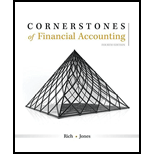
Concept introduction:
Intangible assets:
Intangible assets are those like tangible assets offer future economic benefits to the company but unlike tangible assets they do not have physical existence. Patents, copyrights, trademarks, leaseholds, franchise etc. are some of the examples of intangible assets.
Patent:
Patent is a right given to the company to manufacture, sell or use a particular product and these rights are usually granted for a period of twenty years.
Trademark:
Trademark is a right specifically granted for the use of a distinctive name, symbol or phrase. It is usually granted for a period of ten years but it can be renewed for an indefinite period.
Requirement 1:
Prepare
Concept introduction:
Intangible assets:
Intangible assets are those like tangible assets offer future economic benefits to the company but unlike tangible assets they do not have physical existence. Patents, copyrights, trademarks, leaseholds, franchise etc. are some of the examples of intangible assets.
Requirement 2:
To explain:
Prepare journal entry to record amortization expense for the intangible assets.
Concept introduction:
Intangible assets:
Intangible assets are those like tangible assets offer future economic benefits to the company but unlike tangible assets they do not have physical existence. Patents, copyrights, trademarks, leaseholds, franchise etc. are some of the examples of intangible assets.
Requirement 2:
To explain:
Prepare journal entry to record amortization expense for the intangible assets.
Concept introduction:
Intangible assets:
Intangible assets are those like tangible assets offer future economic benefits to the company but unlike tangible assets they do not have physical existence. Patents, copyrights, trademarks, leaseholds, franchise etc. are some of the examples of intangible assets.
Requirement 3:
To explain:
Record the balance of the intangible assets at the end of 2019.
Trending nowThis is a popular solution!

Chapter 7 Solutions
Cornerstones of Financial Accounting
- Can you help me with General accounting question?arrow_forwardMeridian Corporation started the year with total assets of $480,000 and total liabilities of $215,000. During the year the business recorded $425,000 in revenues, $240,000 in expenses, and dividends of $75,000. Stockholders' equity at the end of the year was____.arrow_forward4 POINTSarrow_forward
- Find the prime costarrow_forwardRiverstone Company began the year with inventory worth $87,500. During the year, they purchased additional inventory for $325,000. At the end of the year, a physical count showed inventory worth $93,200. Calculate the Cost of Goods Sold (COGS) for the period using the periodic inventory system.arrow_forwardPlease provide the accurate answer to this financial accounting problem using valid techniques.arrow_forward
- Can you explain this general accounting question using accurate calculation methods?arrow_forwardCasablanca Corporation has Days Sales Outstanding (DSO) of 15.7 days. Annual sales are expected to be $7,840,000. Using a 365-day year, compute the level of the firm's accounts receivable.arrow_forwardCan you provide the accurate answer to this financial accounting question using correct methods?arrow_forward
 Intermediate Accounting: Reporting And AnalysisAccountingISBN:9781337788281Author:James M. Wahlen, Jefferson P. Jones, Donald PagachPublisher:Cengage Learning
Intermediate Accounting: Reporting And AnalysisAccountingISBN:9781337788281Author:James M. Wahlen, Jefferson P. Jones, Donald PagachPublisher:Cengage Learning Cornerstones of Financial AccountingAccountingISBN:9781337690881Author:Jay Rich, Jeff JonesPublisher:Cengage Learning
Cornerstones of Financial AccountingAccountingISBN:9781337690881Author:Jay Rich, Jeff JonesPublisher:Cengage Learning





